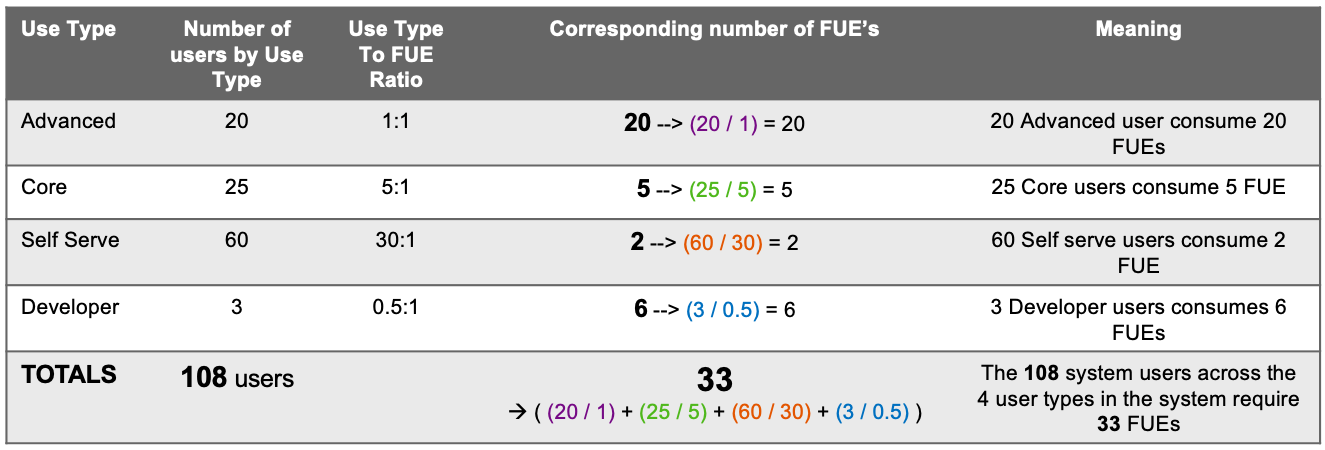
Aprende en Comunidad
Avalados por :





¡Acceso SAP S/4HANA desde $100!
Acceso a SAPCómo definir y aplicar el concepto de FUE en SAP S/4HANA Cloud
- Creado 01/03/2024
- Modificado 01/03/2024
- 312 Vistas
0
Cargando...
Can you have a conversation with my customer about FUEs ?
This is often a phrase used by colleagues from our Customer Success team, that reach out to me asking to have a conversation with their customers, to help them understand what an FUE is, but more importantly why it is important and what it is that they can do to control, monitor and influence it.
Unfortunately, my observations are that most customers start to give attention to this topic at the worst possible time, post go live. At this point, the business users are eager to focus on running their business and reaping the benefits of their investments in SAP S/4HANA Cloud. This delayed realization often results in a moment of sudden clarity accompanied by pain and rework, which can be disruptive.
Personally, I strongly believe that the concept and topic of FUE should be a natural by-product of a well-executed implementation, not a disruptive post-implementation headache.
With this in mind, I shall also try to distill some actions and habits that you can adopt before, during, and after your implementation to make this topic work for you and maybe along the way help to elevate your enterprise architecture maturity and improve your workflows and processes.
Whilst the original intention of this ‘write-up’ was to produce one blog, as details were added in quickly became evident that we needed to break it up into two parts.
I would also at this point be remiss to not mention the valuable inputs and suggestions from my colleagues in the Solution Management, GLAC and SAP S/4HANA RIG teams that contributed to this blog.
Whilst the aim of this blog is certainly not to delve into commercial topics, I have to at least make sure that there is an understanding of what the acronym FUE which I have already used several times stands for and means, otherwise, this blog will be moot! So let’s start with a definition.
FUE is an acronym that stands for Full Use Equivalent . It is the aggregation method by which a Customer may allocate individuals’ access to the Cloud Service in accordance with the ratios set forth in the respective Cloud Supplement, Service Description Guide or Service Use Description . (I have also seen others invariably refer to it as Full User Equivalent or Full Usage Equivalent).
Every customer that signs an SAP S/4HANA Cloud (whether public edition or private edition) contract, will have a reference to it in their contract – i.e to make it simple, there will be one line that says Cloud Service: SAP S/4HANA Cloud…edition, Usage metric: FUE – and Amount: a number of FUEs. That is the quantity of FUEs a customer has purchased and is within a validity period entitled to use. So, I have not really explained in detail what an FUE is, and here I am already introducing another concept, that of Use Type, but is also necessary to understand. The Use Type speaks to the person, the physical user that will be logging on and directly using the SAP S/4HANA Cloud system. Depending on the capabilities and authorizations afforded to that user, a Use Type can be determined. A Use Type can be one of 4 possible classifications, which are as follows:
So, at this point, we have mentioned the terms FUE (which is referenced in the contract) and Use Type (which is determined based on the authorizations and capabilities a user has access to in the system). But how are they connected? Well, each Use Type can be expressed as a ratio of an FUE, as presented below:
And using a concrete example, where we have users across all Use Types.
You can download from SAP support an FUE calculator to help you in this calculation.
The next question you will then probably have is, how do you determine the Use Type under which a user should be classified? For this, I would first direct you to the SAP Trust Centre and download the SDG (Service Description Guide – for private editions
This is often a phrase used by colleagues from our Customer Success team, that reach out to me asking to have a conversation with their customers, to help them understand what an FUE is, but more importantly why it is important and what it is that they can do to control, monitor and influence it.
Unfortunately, my observations are that most customers start to give attention to this topic at the worst possible time, post go live. At this point, the business users are eager to focus on running their business and reaping the benefits of their investments in SAP S/4HANA Cloud. This delayed realization often results in a moment of sudden clarity accompanied by pain and rework, which can be disruptive.
Personally, I strongly believe that the concept and topic of FUE should be a natural by-product of a well-executed implementation, not a disruptive post-implementation headache.
With this in mind, I shall also try to distill some actions and habits that you can adopt before, during, and after your implementation to make this topic work for you and maybe along the way help to elevate your enterprise architecture maturity and improve your workflows and processes.
Whilst the original intention of this ‘write-up’ was to produce one blog, as details were added in quickly became evident that we needed to break it up into two parts.
- The first (this one) will focus on defining and explaining what an FUE and the FUE concept is.
- The second part will focus on those tips and suggestions that you can apply during the lifecycle of your implementation and adoption journey.
I would also at this point be remiss to not mention the valuable inputs and suggestions from my colleagues in the Solution Management, GLAC and SAP S/4HANA RIG teams that contributed to this blog.
Understand what we are talking about.
Whilst the aim of this blog is certainly not to delve into commercial topics, I have to at least make sure that there is an understanding of what the acronym FUE which I have already used several times stands for and means, otherwise, this blog will be moot! So let’s start with a definition.
FUE - A Definition
FUE is an acronym that stands for Full Use Equivalent . It is the aggregation method by which a Customer may allocate individuals’ access to the Cloud Service in accordance with the ratios set forth in the respective Cloud Supplement, Service Description Guide or Service Use Description . (I have also seen others invariably refer to it as Full User Equivalent or Full Usage Equivalent).
Every customer that signs an SAP S/4HANA Cloud (whether public edition or private edition) contract, will have a reference to it in their contract – i.e to make it simple, there will be one line that says Cloud Service: SAP S/4HANA Cloud…edition, Usage metric: FUE – and Amount: a number of FUEs. That is the quantity of FUEs a customer has purchased and is within a validity period entitled to use. So, I have not really explained in detail what an FUE is, and here I am already introducing another concept, that of Use Type, but is also necessary to understand. The Use Type speaks to the person, the physical user that will be logging on and directly using the SAP S/4HANA Cloud system. Depending on the capabilities and authorizations afforded to that user, a Use Type can be determined. A Use Type can be one of 4 possible classifications, which are as follows:
- Advanced Use Type
- Core Use Type
- Self-service Use Type
- Developer Use Type
FUE and Use Type: Connecting the dots
So, at this point, we have mentioned the terms FUE (which is referenced in the contract) and Use Type (which is determined based on the authorizations and capabilities a user has access to in the system). But how are they connected? Well, each Use Type can be expressed as a ratio of an FUE, as presented below:
Use Types available in SAP S/4HANA Cloud and correspondence ratio to FUE
And using a concrete example, where we have users across all Use Types.
Sample scenario converting Use Types into FUEs
You can download from SAP support an FUE calculator to help you in this calculation.
The next question you will then probably have is, how do you determine the Use Type under which a user should be classified? For this, I would first direct you to the SAP Trust Centre and download the SDG (Service Description Guide – for private editions
Pedro Pascal
Se unió el 07/03/2018
Facebook
Twitter
Pinterest
Telegram
Linkedin
Whatsapp
Sin respuestas
 No hay respuestas para mostrar
Se el primero en responder
No hay respuestas para mostrar
Se el primero en responder
© 2025 Copyright. Todos los derechos reservados.
Desarrollado por Prime Institute
Hola ¿Puedo ayudarte?



